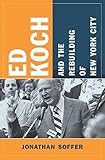Ed Koch and the Rebuilding of New York City / Jonathan Soffer.
Material type: TextSeries: Columbia History of Urban LifePublisher: New York, NY : Columbia University Press, [2010]Copyright date: ©2010Description: 1 online resource (528 p.) : 19 illusContent type:
TextSeries: Columbia History of Urban LifePublisher: New York, NY : Columbia University Press, [2010]Copyright date: ©2010Description: 1 online resource (528 p.) : 19 illusContent type: - 9780231150330
- 9780231520904
- 974.71092 22
- F128.54 .K63 S64 2010
- online - DeGruyter
- Issued also in print.
| Item type | Current library | Call number | URL | Status | Notes | Barcode | |
|---|---|---|---|---|---|---|---|
 eBook
eBook
|
Biblioteca "Angelicum" Pont. Univ. S.Tommaso d'Aquino Nuvola online | online - DeGruyter (Browse shelf(Opens below)) | Online access | Not for loan (Accesso limitato) | Accesso per gli utenti autorizzati / Access for authorized users | (dgr)9780231520904 |
Frontmatter -- Contents -- Acknowledgments -- 1. Introduction -- 2. Struggling to Be Middle Class -- 3. It Takes a Village (1949-58) -- 4. "Rhymes with Notch" (1959-64) -- 5. The Man Who Beat Carmine De Sapio -- 6. A Rebel with Reason -- 7. Koch's Corridor (1969-76) -- 8. "A Liberal with Sanity" -- 9. New York -- 10. The 1977 Mayoral Election -- 11. The Critical First Term (1978-81) -- 12. The Politics of Race and Party -- 13. Shake-up (1979-80) -- 14. Controlled Fusion -- 15. Governor Koch? (1982-83) -- 16. Larger Than Life (1984-85) -- 17. A New Spatial Order -- 18. Homelessness -- 19. The Koch Housing Plan (1986-89) -- 20. AIDS -- 21. Crime and Police Issues (1978-84) -- 22. The Ward Years -- 23. Don't Follow County Leaders, and Watch Your Parking Meters (1986) -- 24. Koch's Endgame (1988-89) -- 25. Epilogue -- Conclusion -- Notes -- Index
restricted access online access with authorization star
http://purl.org/coar/access_right/c_16ec
In 1978, Ed Koch assumed control of a city plagued by filth, crime, bankruptcy, and racial tensions. By the end of his mayoral run in 1989 and despite the Wall Street crash of 1987, his administration had begun rebuilding neighborhoods and infrastructure. Unlike many American cities, Koch's New York was growing, not shrinking. Gentrification brought new businesses to neglected corners and converted low-end rental housing to coops and condos. Nevertheless, not all the changes were positiveAIDS, crime, homelessness, and violent racial conflict increased, marking a time of great, if somewhat uneven, transition. For better or worse, Koch's efforts convinced many New Yorkers to embrace a new political order subsidizing business, particularly finance, insurance, and real estate, and privatizing public space. Each phase of the city's recovery required a difficult choice between moneyed interests and social services, forcing Koch to be both a moderate and a pragmatist as he tried to mitigate growing economic inequality. Throughout, Koch's rough rhetoric (attacking his opponents as "crazy," "wackos," and "radicals") prompted charges of being racially divisive. The first book to recast Koch's legacy through personal and mayoral papers, authorized interviews, and oral histories, this volume plots a history of New York City through two rarely studied yet crucial decades: the bankruptcy of the 1970s and the recovery and crash of the 1980s.
Issued also in print.
Mode of access: Internet via World Wide Web.
In English.
Description based on online resource; title from PDF title page (publisher's Web site, viewed 02. Mrz 2022)


